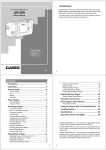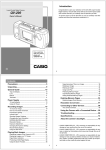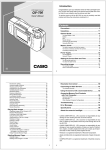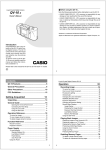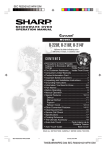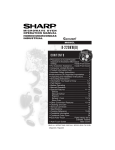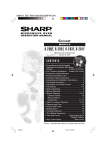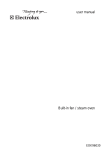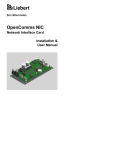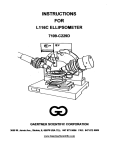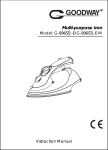Download Casio QV-70 Owner`s manual
Transcript
Introduction Congratulations upon your selection of the QV-70 LCD Digital Camera. The QV-70 comes with its own built-in liquid crystal color monitor that let’s you instantly view the pictures you take. LCD Digital Camera QV-70 To get the most out of the QV-70, be sure to carefully read this manual and follow the instructions contained in it. Owner’s Manual DE L /PR OT EC T ON ZO OM DIS P MO DE + PO WE R /OF F – RE C PL AY LC ON D /OF F 英 2 Contents Precautions .......................................................... 5 Using Auto Play .................................................................. 42 Protecting Memory Pages .................................................. 44 Hiding Protected Memory Pages ........................................ 47 Unpacking ............................................................. 9 General Guide .................................................... 10 Top and Display .................................................................. Lens .................................................................................... Bottom ................................................................................ Terminals ............................................................................ Deleting Memory Pages .................................... 48 10 10 11 11 To delete a single memory page ........................................ 48 To delete all unprotected memory pages ........................... 51 Connecting to Other Devices ............................ 54 The camera terminals ......................................................... 54 Power Supply ..................................................... 13 Using the Camera with a Connected Device ...... 55 To load batteries ................................................................. 13 Using AC Power ................................................................. 18 Troubleshooting ................................................. 61 Recording Images .............................................. 20 To record an image ............................................................. How to avoid hand movement… ......................................... Fluorescent Lighting ........................................................... Shooting images outdoors .................................................. NORMAL/MACRO Switch .................................................. Exposure Adjustment .......................................................... Changing the Aperture Setting ........................................... Record Mode Displays ........................................................ Using the Self-Timer ........................................................... Specifications ..................................................... 68 20 22 23 23 24 25 26 27 31 About the camera’s backlight… ....................... 70 • CASIO COMPUTER CO., LTD. assumes no responsibility for any damage or loss resulting from the use of this manual. • CASIO COMPUTER CO., LTD. assumes no responsibility for any loss or claims by third parties which may arise through the use of the QV-70. Playing Back Images ......................................... 32 Displaying Images on the Camera’s LCD ........................... Displaying Images on a TV Screen .................................... Displaying the Memory Page Number ................................ Producing a Multi-Page Display .......................................... Using the Zoom Function .................................................... 32 34 35 36 40 • CASIO COMPUTER CO., LTD. assumes no responsibility for any damage or loss caused by deletion of data as a result of malfunction, repairs, or battery replacement. Be sure to back up all important data on other media to protect against its loss. 3 4 Precautions LCD Digital Camera General Precautions • Physical damage and malfunction of this unit can cause the image data stored in its memory to be deleted. Be sure to always keep backup copies of data by transferring them to personal computer memory. Be sure to observe the following important precautions whenever using the QV-70. All references in this manual to “this camera” and “the camera” refer to the CASIO QV-70 Digital Camera. • Never open the battery compartment cover, disconnect the AC adaptor from the camera or unplug it from the wall socket while the “WAIT” message is on the LCD. Doing so will not only make storage of the current image impossible, it can also corrupt other image data already stored in camera memory. • Never try to take pictures or use the built-in display while operating a motor vehicle or while walking. Doing so creates the danger of serious accident. • Never try to open the case of the camera or attempt your own repairs. High-voltage internal components create the risk of electrical shock when exposed. Always leave maintenance and repair work up to authorized CASIO service providers. MEMORY ERROR message Any of the following can cause data stored in the camera’s memory to become corrupted. • Keep the camera away from water and other liquids, and never let it get wet. Moisture creates the danger of fire and electrical shock. Never use the camera outdoors in the rain or snow, at the seashore or beach, in the bathroom, etc. • Removal of batteries or disconnection of the AC adaptor during a record or data communication operation • Disconnection of the connecting cable during data communication • Should foreign matter or water ever get into the unit, immediately turn power off, unplug the AC adaptor from the power outlet, and contact your dealer or nearest CASIO service provider. Using the unit under these conditions creates the danger of fire and electrical shock. • Continued use while battery power is low • Other incorrect operation In each of the above cases, further operation of the camera becomes impossible and one of the messages shown below eventually appears to inform you of the problem. See “Messages” on page 67 for details on what you should do when one of these messages appears. • Should you ever notice smoke or a strange odor coming out of the unit, immediately turn power off and unplug the AC adaptor from the power outlet. Using the unit under these conditions creates the danger of fire and electrical shock. After making sure there is no more smoke coming from the unit, take it to your nearest CASIO service provider for repair. Never attempt your own maintenance. • If the unit’s case should ever become cracked due to dropping it or otherwise subjecting it to rough treatment, immediately turn power off, unplug the AC adaptor from the power outlet, and contact your nearest CASIO service provider. • Never use the unit inside of an air craft or in any other areas where its use is prohibited. Doing so can result in an accident. MEMORY ERROR #1 YES→ + NO →CALL TECH SUPPORT! MEMORY ERROR #2 CONSULT THE OWNER'S MANUAL! MEMORY ERROR #3 CONSULT THE OWNER'S MANUAL! Memory Error #1 Memory Error #2 Memory Error #3 See page 67 5 Contact your dealer or an authorized CASIO service provider. 6 Precautions LCD Digital Camera Operating conditions GUIDELINES LAID DOWN BY FCC RULES FOR USE OF THIS UNIT IN THE U.S.A. (not applicable to other areas). • This camera is designed for use in temperatures ranging from 0°C to 40°C (32°F to 104°F). This device complies with Part 15 of the FCC Rules. Operation is subject to the following two conditions: (1) this device may not cause harmful interference, and (2) this device must accept any interference received, including interference that may cause undesired operation. • Do not use or keep the camera in the following areas. — In areas subject to direct sunlight — In areas subject to high humidity or dust — Near air conditioners, heaters, or other areas subject to temperature extremes NOTICE This equipment has been tested and found to comply with the limits for a Class B peripheral, pursuant to Part 15 of the FCC Rules. These limits are designed to provide reasonable protection against harmful interference in a residential installation. This equipment generates, uses and can radiate radio frequency energy and, if not installed and used in accordance with the instructions, may cause harmful interference to radio communications. However, there is no guarantee that interference will not occur in a particular installation. If this equipment does cause harmful interference to radio or television reception, which can be determined by turning the equipment off and on, the user is encouraged to try to correct the interference by one or more of the following measures: • Reorient or relocate the receiving antenna. • Increase the separation between the equipment and receiver. • Connect the equipment into an outlet on a circuit different from that to which the receiver is connected. • Consult the dealer or an experienced radio/TV technician for help. FCC WARNING Changes or modifications not expressly approved by the party responsible for compliance could void the user's authority to operate the equipment. Properly shielded cables with ferrite core must be used for connection to host computer and/or peripherals in order to meet FCC emission limits. — Inside of a closed vehicle, especially one parked in the sun — In areas subject to strong vibration Condensation • When you bring the camera indoors on a cold day or otherwise expose it to a sudden change of temperature, there is the possibility that condensation can form on the exterior or on interior components. Condensation can cause malfunction of the camera, so you should avoid exposing it to conditions that might cause condensation. • To keep condensation from forming, place the camera into a plastic bag before moving it into a location that is much warmer or colder than your current location. Leave it in the plastic bag until the air inside the bag has a chance to reach the same temperature as the new location. If condensation does form, remove the batteries from the camera and leave the battery compartment cover open for a few hours. THE SPECIAL VIDEO CABLE THAT COMES WITH THE CAMERA ----- THE CAMERA TO A VIDEO IN TERMINAL OF A COMPUTER THE SPECIAL CONNECTION CABLE THAT COMES WITH QV-Link SOFTWARE ----- THE CAMERA TO A PROPER TERMINAL OF A COMPUTER 7 8 Unpacking General Guide Getting Acquainted Check to make sure that all of the items shown below are included with your camera. If something is missing, contact your dealer as soon as possible. The following illustrations show the names of each component, button and switch on the camera. Top and Display ZOOM button – /PROTECT (Timer/Protect) button DISP (Display) button MODE button /PRO ON PO WER F /OF + MO DE DISP DE L /PRO TECT ZO OM DEL (Delete) button DEL TECT ZOOM DISP MOD [+] (Forward) button E + ON POW /OFF ER Soft case – Viewfinder Shutter button Operation indicator Camera RE C [–] (Reverse) button PL AY Alkaline batteries (AA-size × 3) LC POWER switch ON D /OFF LCD LCD button Function switch Lens Manual NORMAL/MACRO switch – ON /OFF PO WER + MO DE L /PRO TECT ZO OM Wrist Strap DE DISP Self-timer indicator Special video cable Lens Aperture switch 9 Bottom 10 General Guide Getting Acquainted Tripod hole Self-timer Indicator and Operation Indicator • Self-timer Indicator This indicator flashes when the camera’s self-timer is activated. • Operation Indicator This indicator stays lit while power is on. Its color changes as shown below to indicate various operating conditions. Battery compartment cover BRIGHT (brightness) control • BRIGHT control adjusts the brightness of the image on the LCD. The brightness is set at the factory to the optimum setting, and normally does not need adjustment. Terminals Color Lit Flashing Green Power on Recording Orange Exposure warning Battery warning Red Memory full — – ON POW /OF ER F + MO DE DISP DE L /PRO MO TECT ZO OM AC Power terminal Connecting the Wrist Strap Pass the wrist strap through the hole on the side of the camera as shown in the illustration. DIGITAL terminal VIDEO OUT terminal PO OFF WE DE + R – RE C PL AY LC D /OF ON F Terminal panel cover Important! • To avoid possible damage caused by accidently dropping the camera, be sure to use the wrist strap to secure the camera to your wrist whenever using it. Opening the Terminal Panel Cover Using the Soft Case Keep the camera in its soft case to protect it when not in use. Important! • When closing the terminal panel cover, make sure that the plugs on the inside of the cover align with and enter the terminals. • Never forcibly pull on or twist the terminal panel cover. Undue force can damage the cover. 11 12 E MOD M DIS + P ZOO – ER POW FF ON/O Power Supply Getting Acquainted 3. The camera features a two-way power supply that lets you use either batteries (AA-size Alkaline or Lithium) or household AC current. Close the battery compartment cover. To load batteries Be sure that camera power is turned off whenever loading or replacing batteries. 1. Slide the battery compartment cover in the direction indicated by the arrow in the illustration. While pressing the stopper, slide the case in the direction indicated by the arrow. Battery Handling Precautions Incorrect use or handling of batteries can cause them to leak or burst and seriously damage your camera. Be sure to note the following important precautions to avoid problems with batteries. Insert three batteries. + – 2. Caution Be sure to use Alkaline or Lithium batteries. Never use manganese batteries (see precautions on the next page). • Make sure that the positive + and negative - ends of the batteries are facing correctly. 13 • Use only LR6 (AM-3) type alkaline or FR6 type lithium dry cell batteries with this camera. Never mix old batteries with new ones. Failure to do so can result in bursting or leaking of batteries, creating the danger of fire or personal injury. • Always make sure that the positive [+] and negative [–] ends of the batteries are facing correctly, as noted by the markings on the camera itself. Improper loading of batteries can result in bursting or leaking of batteries, creating the danger of personal injury or soiling of objects nearby. 14 Getting Acquainted Power Supply Low Battery Indicator • Remove batteries from the camera if you do not plan to use it for more than two weeks. A low battery indicator ( ) appears on the LCD and the operation indicator flashes orange whenever remaining battery power drops below a certain level. • Never recharge batteries, never allow direct connection between two ends of a battery, and never try to take batteries apart. • Do not expose batteries to direct heat or dispose of them by burning. Doing so can create the danger of explosion. • Never mix batteries of different types. • Dead batteries are susceptible to leakage, which can cause serious damage to your camera. Remove batteries from the camera as soon as you notice they are dead. • The batteries that power this camera normally become warm when they lose power. This does not indicate malfunction. The above indications mean that the camera will soon turn off automatically if you continue using it. Replace all three camera batteries with new ones as soon as possible. Standard Battery Life The battery life reference values given below indicate the amount of time at standard temperature (25°C) until power automatically turns off due to battery failure. They do not represent a guarantee that batteries will perform for any amount of time. Actual battery life depends on the battery brand, when the battery was manufactured, and ambient temperature where the battery is being used. LCD ON* LCD OFF* REC (one image per 10 seconds) LR6(AM3)AA-size alkaline batteries 400 images 1,600 images FR6 AA-size lithium batteries 800 images 2,200 images PLAY (Auto Play) LR6(AM3)AA-size alkaline batteries 70 minutes 270 minutes FR6 AA-size lithium batteries 150 minutes 440 minutes Flash Memory The camera features flash memory for storage of images. Flash memory does not require electrical power to store data, so image data is retained in memory even when you turn camera power off. If batteries go dead, simply load a set of new batteries or connect the AC adaptor and you will be able to view images in camera memory. * Values in these columns are approximations intended for reference only. 15 16 Getting Acquainted Power Supply Auto Power Off Using AC Power Power automatically turns off whenever you do not perform any camera operation for a period of time. Power turns off after about one minute in the Record Mode or after about three minutes in the Playback Mode. To power the camera from standard AC power, use the optional AC adaptor (AD-C67). AC power terminal AC adaptor – ON/ POWE OFF R + DIS P /PR OT EC T MO DE ZO OM POWER ON/OFF DE L • To restore power, simply slide the POWER switch to the right as you normally do. – AC outlet Important! The Auto Power Off function does not operate under the following conditions. Caution • During Auto Play (page 42) • When operations are being performed on a computer connected to the camera via the camera’s DIGITAL terminal. • Whenever the AC adaptor is connected to the camera. 17 18 Recording Operation Power Supply Caution AC Adaptor precautions • Never use an electrical outlet whose voltage is outside the rating marked on the camera. Doing so can create the danger of fire,malfunction,or electrical shock. Use only the optional AC adaptor specified for this camera. • Should the cord of the AC adaptor become damaged (exposed internal wiring or shorts), request a replacement from an authorized CASIO service provider. A damaged AC adaptor cord creates the danger of fire, malfunction,or electrical shock. • Always be sure to use the AD-C67 AC adaptor only. Using any other AC adaptor can cause damage to the camera not covered by the warranty. • When unplugging the AC adaptor from the wall socket, be sure to grasp the adaptor (not the cord). • Avoid an undue bending, pulling, and twisting of the AC adaptor's cord, and never try to lengthen the cord by splicing it with other wire. Images The following procedure provides the basic steps for recording an image. To record an image 1. Enter the Record Mode. • 2. • Be sure to switch power off before connecting or disconnecting the adaptor. • Always turn camera power off before disconnecting the AC adaptor, even if the camera has batteries installed. If you don't, the camera will turn off automatically when you disconnect the AC adaptor. Even so, you run the risk of damaging the camera whenever you disconnect the AC adaptor without first turning power off. • The AC adaptor may become warm to the touch after extended periods of use. This is normal and is not cause for alarm. 3. • After use turn off the power switch of the camera and unplug adaptor from the AC outlet. REC Slide the function switch to the REC position. Turn on the camera. PLAY • Slide the POWER switch in the direction indicated by the arrow. • The POWER switch automatically slides back to its original position when you release it. • When power comes on, the image of the object that is in front of the camera’s lens appears on the LCD. • You can perform steps 1 and 2 in either order (1 then 2, or 2 then 1). Set the NORMAL/MACRO switch to tion. • POWER ON/OFF – (NORMAL) posi- If the object whose image you are recording is about 15 centimeters from the lens (about 6 inches), set the NORMAL/MACRO switch to (MACRO). See page 24 for details on using this switch. Note • The camera is designed to refresh the image on the LCD about seven times per second. Because of this, you may experience a feeling of jerkiness in the changing image if you move the camera quickly. This is normal and does not indicate malfunction. 19 20 Recording Images Operation 4. Record the image. • Compose the image you want to record while viewing it on the LCD. • It is best to look at the LCD directly, and not from an angle. • If you plan to use the viewfinder to compose the image, press the LCD button to turn off the LCD. • You can use the camera to take the next picture after the “WAIT” message disappears or after the operation indicator stops flashing green. • Here you could change the function switch to the PLAY position and view the image you just recorded. • Note that turning off the camera’s LCD helps to conserve battery power. REC PLAY LCD ON/OFF Caution • Never remove the camera’s batteries while the “WAIT” message is on the LCD or the operation indicator is flashing green. Doing so not only cancels storage of the image being recorded, it can also corrupt other image data already stored in camera memory. The area of the image recorded by the camera may differ slightly from the area that appears within the viewfinder. For more precise image composition, use the LCD monitor screen instead of the viewfinder. How to avoid hand movement… • When using the MACRO setting, the field of view of the viewfinder is very different from the area that is photographed. Because of this, you should always use the camera’s LCD monitor screen to compose images when using the MACRO position. • Take care that your finger is not blocking the lens. • When the image is situated on the LCD as you want it, press the shutter button. • Press the shutter button lightly to avoid moving the camera. See page 22 for information on how to avoid hand movement. • • Any hand movement when you press the shutter button can causes blurring of the recorded image. Note the following points on avoiding hand movement. • Make sure there is no excessive movement of the image of the object on the LCD. • Use a tripod whenever possible when recording images in dim lighting. The camera automatically adjusts shutter speed in accordance with the brightness of the object whose image is being recorded. Shutter speed is quite slow for dimly lit objects, increasing the possibility of blurring caused by hand movement. The message “WAIT” appears on the LCD for about six seconds along with the image that was recorded when you pressed the shutter button. You can use the camera to take the next picture after the “WAIT” message disappears. 21 22 Operation Recording Images Fluorescent Lighting NORMAL/MACRO Switch The NORMAL/MACRO switch tells the camera how much distance there will be between the lens and the object whose image you are recording. The following table describes the conditions covered by each switch setting. When using the MACRO setting, the field of view of the viewfinder is very different from the area that is photographed. Because of this, you should always use the camera’s LCD monitor screen to compose images when using the MACRO position. Fluorescent lighting actually flickers at a frequency that cannot be detected by the human eye. When using the camera indoors under such lighting, you may experience some brightness or color problems with recorded images. The actual extent of the problems depends on what cycle of the fluorescent light’s flicker is occurring when the camera’s shutter actually releases. For best results, use a commercially available video lights. Shooting Images Outdoors (NORMAL) Switch position Strong direct or reflected sunlight can cause recorded images to take on a greenish tinge. This is due to the characteristics of the camera’s charge-coupled device (CCD), and it does not indicate malfunction of the camera. One way you can try to minimize this problem is to set the aperture to [●] (F8). Aperture F2.8(○) F8 (●) (MACRO) 0.6 to 3.0 meters For portraits taken indoors (2.0~9.8 feet) 12 to 14 cm For close ups taken indoors (4.7"~5.5") 0.4 meters to ∞ For general outdoor images (1.3 feet~) 10 to 18 cm For outdoor close-ups (3.9"~7.1") The above figures indicate the distance from the lens protection filter to the subject. * See page 26 for details on how to change the aperture. F2.8(○) F8(●) 12∼14cm (4.7"∼5.5") 10∼18cm (3.9"∼7.1") MACRO 0.6∼3.0m (2.0∼9.8 feet) 0.4m∼ (1.3 feet∼) NORMAL 23 24 ∞ Recording Images Operation Exposure Adjustment Notes This camera features an automatic exposure (AE) function that automatically changes the shutter speed in accordance with lighting. In addition, you can also manually adjust the exposure to compensate for backlighting, indirect indoor lighting, dark backgrounds, and other special conditions. • Exposure adjustment is generally expressed in terms of an exposure adjustment value. The exposure adjustment value is always set to zero whenever you turn on the camera. To manually adjust the exposure • The exposure adjustment value automatically reverts to zero whenever the shutter button is pressed. You can manually reset the exposure adjustment value by using [+] and [–] to change the value back to zero, which is indicated when the + – indicator disappears from the monitor. • The exposure adjustment value is changed by 0.25EV with each press of [+] or [–]. The range of the value is -2EV to +2EV. REC 1. Enter the Record Mode. • 2. Set the function switch to the REC position. PLAY Use the [+] and [–] buttons to manually adjust the exposure. • • Pressing [+] makes the image on the LCD brighter. Use it to adjust for dim indoor lighting and backlighting. DISP Changing the Aperture Setting MODE + POWER ON/OFF There are two aperture settings you can use to match lighting conditions. Use the aperture switch to change the aperture setting. – Pressing [–] makes the image on the LCD darker. Use it to adjust for bright sunlight. • Use the [●] (F8) setting to decrease exposure. This setting works best outdoors. • Use the [○] (F2.8) setting to increase exposure. This setting works best indoor and with back lit images. 【+】 +– Note • Also see page 28 for information about exposure warning indicators. 【−】 +– 3. After adjusting the exposure, press the shutter button to record the image. 25 26 Operation Recording Images Record Mode Displays • The image number appears in the upper right corner of the LCD. It indicates the number of the next image that will be recorded. The number 21, for example, indicates that there are 20 images in memory, and the next image will be number 21. • To clear the image number from the LCD, press the DISP button again. The following provides details on the images, indicators and messages that appear on the LCD in the Record Mode. If the LCD is turned off, press the LCD button to turn it on. Image Display An image of the object that is picked up by the camera’s lens appears on the LCD. The camera is designed to refresh the image on the LCD about seven times per second. Because of this, you may experience a feeling of jerkiness in the changing image if you move the camera quickly. This is normal and does not indicate malfunction. Note • The LCD image that appears in the Playback Mode is more detailed than the image produced in the Record Mode. Because of this, you should consider the Record Mode image to be a reasonable facsimile of the image that is actually stored in memory. • Note that turning display of the image number on and off in the Record Mode also affects the display of the memory page number in the Playback Mode (page 35), and the zoom area indicator used in the zoom operation (page 40). If you turn display of the image number off in the Record Mode, for example, the memory page number will not be shown in the Playback Mode. Displaying the Image Number Exposure Warning Indicators The image number is a value that indicates the number of the next image that will be recorded. Up to 96 images can be stored in camera memory. An exposure warning indicator appear on the LCD and the operation indicator lights orange whenever the light being picked up by the lens would result in under exposure or over exposure of an image. Note 1. Enter the Record Mode. REC • Set the function switch to the REC position. PLAY 2. Press the DISP button. /PROTECT ZOOM DISP MODE + Under exposure 27 28 Over exposure Recording Images Operation Important! • Note that power will turn off quicker if you are using the optional Connection Kit for data communications through the camera’s DIGITAL terminal when the low battery condition occurs. This is to protect against problems due to sudden power failure during data transfer. • The exposure warning indicators also appear when lighting is outside the range of the camera. In such a case, changing the aperture will not clear the indicator from the LCD. • We strongly recommend that you use the optional AC adaptor whenever sending or receiving data over the camera’s DIGITAL terminal. • The manual exposure adjustment procedure (page 25) cannot be used when an exposure warning indicator is on the LCD. Clear the warning indicator by changing the aperture switch setting. • See page 13 for details on how to replace batteries. • Pressing the [+] or [–] button to adjust exposure while an exposure warning indicator is on the LCD causes a + – exposure value to appear. This is an EV value. Memory Full Message Use the procedure described on page 26 to change the aperture or change the lighting of the image so the indicator disappears from the LCD. The message “MEMORY FULL” appears on the LCD and the operation indicator flashes red whenever you press the shutter button while camera memory is full. If you want to record more images, you must first delete some of the images already stored in camera memory. See page 48 for details on how to delete images. Low Battery Indicator The low battery indicator ( ) appears on the LCD and the operation indicator flashes orange whenever remaining battery power drops below a certain level. The above indications mean that the camera will soon turn off automatically if you continue using it. Replace all three camera batteries with new ones as soon as possible. 29 30 Playing Operation Recording Images Using the Self-Timer This section describes how to recall and view images stored in camera memory. If the LCD is turned off, press the LCD button to turn it on. With the Self-Timer, the shutter is released 10 seconds after you /PROTECT button. press the 1. Displaying Images on the Camera’s LCD Enter the Record Mode. • Set the function switch to the REC position. Back Images REC The camera can store up to 96 images in memory. Images are sequentially numbered from 1 through 96. Think of camera memory like a 96-page album of the images you record. PLAY 2. The following procedure describes how to display images on the camera’s built-in LCD. Start the Self-Timer operation. • • • • Place the camera securely on a tripod, desk or other stable surface, with the image to be recorded in the LCD. After composing the image, press /PROTECT button. the The timer countdown is indicated by the flashing of the Self-timer indicator. The image on the LCD also clears when the countdown begins. The LCD image reappears after shutter is released and the image is recorded. To cancel on ongoing Self-Timer /PROoperation, press the TECT button or shutter button. 1. Enter the Playback Mode. REC • /PROTECT ZOOM DISP MODE 2. + PLAY Turn on the camera. • Self-timer indicator /PROTECT ZOOM DISP Important! • If battery power is low, camera power may turn off while a countdown is in progress. If this happens, replace the batteries with new ones. 31 32 Slide the POWER switch in the direction indicated by the arrow. The POWER switch automatically slides back to its original position when you release it. • When power comes on, the page that was displayed when you last turned power off appears on the LCD. • You can perform steps 1 and 2 in either order (1 then 2, or 2 then 1). MODE + Slide the function switch to the PLAY position. POWER ON/OFF – Playing Back Images 3. Operation Displaying Images on a TV Screen Scroll through the memory pages until the image you want to view is displayed. • Use the special video cable that comes with the camera to connect it to a television as illustrated below, and you can then view the images stored in camera memory on the TV’s screen. Note that turning off the camera’s LCD helps to conserve battery power. Press [+] to display the next memory page or [–] to display the previous memory page. 【+】 【+】 【−】 【−】 Important! • The camera can be connected only to a TV that is equipped with a VIDEO IN terminal. • Make sure that the power of both the camera and the TV are turned off when making connections. • The signal output through this camera's VIDEO OUT terminal is an NTSC signal. An image output through this terminal will not look normal if the camera is connected to a PAL or other type of TV or video deck. Leaving the same image displayed on a TV or computer CRT screen for very long periods can cause that image to “burn in,” leaving a ghost of the image even after the original image is cleared. Be sure not to leave an image on a TV or CRT screen for long periods. Notes • If you set the function switch to PLAY after recording an image, that image appears on the LCD first. • The message “MEMORY EMPTY” appears on the LCD if there are no images stored in memory when you enter the Playback Mode. TV VIDEO OUT terminal VIDEO IN terminal – ON POWE /OF R F + DIS /PR OT EC T ZO P MO DE OM R L L DE INPUT VIDEO AUDIO Accessory video cable After connecting the camera and TV, set the channel of the TV to the channel used for video input. 33 34 Operation Playing Back Images After connecting the camera and TV, use the same procedures as those described under “Displaying Images on the Camera’s LCD” on page 32. Notes Important! • The letter “P” next to the memory page number indicates that page is “protected” and cannot be deleted. See page 44 for details about protecting memory pages. • Note that only images already stored in camera memory can be viewed on the TV screen. If you change to the camera’s Record Mode, the image picked up by the camera’s lens will not appear on the TV screen. • Note that turning display of the memory page number on and off in the Playback Mode also affects the display of the image number in the Record Mode (page 27), and the zoom area indicator used in the zoom operation (page 40). Displaying the Memory Page Number Producing a Multi-Page Display The memory page number is a value in the upper right corner of the LCD that indicates the number of the currently shown memory page. Four or nine memory pages can be displayed at the same time. This feature can be used to display multiple memory pages on the camera’s built-in LCD, or on the screen of a connected TV. 1. Enter the Playback Mode. 1. 2. REC • Set the function switch to the PLAY position. PLAY 2. Enter the Playback Mode and turn on the camera. Switch to multi-page display. • Press the MODE button to change between the different display formats. • Each press of MODE changes the display format in the following sequence. • You cannot use the multi-page display while protected memory pages are hidden (page 47). Press the DISP button. /PROTECT ZOOM DISP MODE + • The memory page number appears in the upper right corner of the LCD. • To clear the memory page number from the LCD, press the DISP button again. 35 36 REC PLAY /PROTECT ZOOM DISP MODE + Playing Back Images Operation Selecting a Memory Page in a Multi-Page Display You can use the following procedure to select one of the memory pages in a multi-page display. Then when you return to the 1-page display, the memory page you selected will be the one displayed. The following procedure uses the 4-page display as an example, but you can use the same procedure with the 9-page display. 1. In the Playback Mode, press the MODE button. * The memory page that is shown on the screen when you change to the 4-page or 9-page format is in the first (upper left) position in the multi-page display. 3. /PROTECT ZOOM • Use [+] (forward) and [–] (back) to scroll through the memory pages. Pages are scrolled one, four, or nine at a time, depending on the display format you are using. 1 2 3 4 【+】 【−】 5 6 7 8 【+】 【−】 9 2. 10 Press the DISP button. • This causes a white line to appear under the first (upper left) page. This white line indicates the memory page that is currently selected. • If you do not perform any operation for about 10 seconds, the white line disappears from the display. 11 Note • The brightness of the images on a multi-page display may differ slightly from the brightness when a single image is shown. This is because the camera automatically uses the brightness setting for the brightest image contained in the multi-page display for all of the images. 37 38 Operation Playing Back Images Using the Zoom Function Move the white line to the memory page that you want to select. • Press [+] to move the line to the right or [–] to move it to the left. In this example, press [+] three times or [–] once. This function lets you select a specific part of a stored image and enlarge it to twice its normal size. 【+】 X 3 1. 2. Display an image. Press the ZOOM button to zoom in on the center of the image. • 4. This changes to the 4-page display. In this example, we will select this page. Unused pages are colored gray. 3. MODE + Scroll through the pages on the display. • DISP The center of the image is enlarged to twice its normal size. Press the ZOOM button. • The image in the selected memory page appears as a 1page display. /PROTECT ZOOM DISP MODE + 3. Change the position of the zoom area. • 4. 39 40 You can use [+] and [–] to change the position of the zoom area in the sequence shown on page 41. Press the ZOOM button again to return the image to its original size. Playing Back Images Operation Using Auto Play Changing the Location of the Zoom Area Auto play lets you automatically scroll through the camera’s memory pages quickly and easily. You can specify the speed of the scroll. 【+】 【+】 【+】 Important! 【+】 【+】 【+】 【+】 【+】 【+】 • The camera’s Auto Power Off function (page 17) does not function while an auto play operation is in progress. If you forget to turn the camera off, there is the danger that auto play will continue until batteries are dead. To avoid this, make sure that you stop the auto play operation and turn the camera off when you finish viewing. To start the auto play operation 1. 2. • Pressing [–] moves the zoom area in the opposite direction. Notes • If the page number is displayed in the upper right corner of the screen when you perform a zoom operation, the number is replaced by a zoom area indicator. This indicator shows you what part of the image is currently enlarged on the display. You can turn the zoom area indicator on and off by pressing the DISP button. Enter the Playback Mode and turn on the camera. Start the auto play operation. • Hold down the [+] and [–] buttons until the message “AUTO PLAY START” appears. • There must be at least two images (two pages) recorded in memory to use the auto play operation. Otherwise, the “AUTO PLAY START” message will not appear on the display. • After about one second, this message disappears and the auto play operation starts. Zoom area indicator • Note that turning display of the zoom area indicator on and off during a zoom operation also affects the display of the image number in the Record Mode (page 27), and the memory page number in the Playback Mode (page 35). 41 42 Operation Playing Back Images Protecting Memory Pages You can protect specific memory pages to ensure that they are not accidently deleted. 3 seconds • 3. 3 seconds To protect a page 1. Auto play continues to loop through the memory pages. This means that when it reaches the last page, it starts again from the first page. Enter the Playback Mode and turn on the camera. • Slide the function switch to the PLAY position. • Slide the POWER switch in the direction indicated by the arrow. • If the page number is not shown in the upper right of the page, press DISP. Press the shutter button to stop the auto play operation. • Pressing any button stops the auto play operation. + – • • Note that the buttons of the camera do not operate while a page change operation is in progress. Make sure that an image is shown on the display when you press a button to stop the auto play operation. /PROTECT ZOOM DISP MODE + Page number You can also use auto play with the multi-page display. Change to the multi-page display first, and then start auto play. 2. Scroll through the memory pages until the one you want to protect is displayed. • • 43 44 Press [+] to display the next memory page or [–] to display the previous memory page. You cannot protect or unprotect memory pages while protected memory pages are hidden (page 47). DISP MODE + POWER ON/OFF – Playing Back Images Operation To unprotect a page 3. 1. Enter the Playback Mode and turn on the camera. 2. Scroll through the memory pages until the one you want to unprotect is displayed. 3. Press the Protect the page. • • /PROTECT button Press the to protect the page. /PROTECT ZOOM DISP MODE + The letter “P” appears to the right of the page number to indicate that page is protected. • Protect indicator /PROTECT button. The letter “P” disappears, indicating that page is no longer protected. Note /PRO• If the page number is not displayed when you press the TECT button, the page number along the protect indicator appears about a second after you press the button. Note /PRO• If the page number is not displayed when you press the TECT button, the page number appears about a second after you press the button. 45 46 Deleting Operation Playing Back Images Hiding Protected Memory Pages Memory Pages Use the procedures described in this section to delete memory pages. You can delete individual pages, or all the pages currently stored in memory. This function makes it possible for you to hide protected memory pages so their images do not appear on the monitor during playback. Warning! To hide protected memory pages The delete operation cannot be undone! While holding down the [+] button, turn on the camera. Before performing any of the procedures described in this section, make sure that you really do not need the images recorded on the memory pages you are deleting. Be especially careful when you are using the all delete operation. Important! • You cannot protect or unprotect pages (pages 44~46) while protected pages are hidden. • You cannot display multiple images (page 36) while protected pages are hidden. To delete a single memory page • The following message appears on the monitor when you hide protected memory pages and all pages currently in memory are protected. It also appears if you delete all unprotected memory pages while protected memory pages are hidden. 1. 2. Enter the Playback Mode and turn on the camera. • Slide the function switch to the PLAY position. • Slide the POWER switch in the direction indicated by the arrow. Scroll through the memory pages until the one you want to delete is displayed. • Press [+] to display the next memory page or [–] to display the previous memory page. • Remember that you cannot delete a protected page. If the page you want to delete is protected, use the procedure on page 46 to unprotect it before proceeding. • You cannot delete memory pages while using multi-page display (page 36), zoom function (page 40), or auto play (page 42). To unhide protected memory pages While holding down the [–] button, turn on the camera. 47 48 Deleting Memory Pages 3. Press DEL. /PROTECT ZOOM DISP Operation • MODE To abort the delete operation without deleting anything, press DEL. DEL 6. One-page delete All page delete Exit this screen 4. • 7. Press the [+] button to specify deletion of a single page. • If the page you selected in step 2 is protected, the contents of the nearest unprotected page appear in the above screen. DISP • + • Deleting a page causes the remaining pages to be renumbered. Blank pages are not left inserted between non-blank pages. 1 2 3 Make sure that you really want to delete the page that contains the contents shown on the display. 1 2 3 • 4 You can use [+] and [–] to change the memory page. When you do, protected pages are skipped (not displayed). 49 50 Deleting Memory Pages Operation To delete all unprotected memory pages 1. Enter the Playback Mode and turn on the camera. 2. Press DEL. /PROTECT ZOOM Warning! DISP The following operation deletes all unprotected memory pages and cannot be undone. Make sure that you do not need any of the images stored in memory before performing this operation. MODE 4. DEL One-page delete All page delete Exit this screen 3. After you are finished deleting pages, press DEL to exit the delete operation. Note – ON/OFF + – Repeat steps 5 and 6 as many times as you want to delete memory pages. MODE POWER Pressing the shutter button deletes the page you selected and displays the next page. * This screen clears automatically from the display if you do not perform any operation for about 30 seconds. The contents of the memory page you displayed in step 2 appear here. 5. * This screen clears automatically from the display if you do not perform any operation for about 30 seconds. To delete the page whose contents are shown, press the shutter button. To delete all unprotected pages, press the shutter button. • If there were no protected pages in memory, the message “MEMORY EMPTY” appears on the display after all memory pages are deleted. • If there were protected pages in memory, they are the only pages that remain after the delete operation is complete. * This screen clears automatically from the display if you do not perform any operation for about 30 seconds. Press the [–] button to specify deletion of all unprotected pages. • To abort the delete operation without deleting anything, press DEL. DISP MODE + POWER ON/OFF – * This screen clears automatically from the display if you do not perform any operation for about 30 seconds. 51 52 Connecting Other Connecting to Other to Devices Deleting Memory Pages • Devices The camera terminals The message shown below appears on the monitor screen whenever you try to delete all memory pages while there are protected pages in memory and those pages are hidden. The following describes which the camera terminal you should use for each type of connection. VIDEO OUT – Use this terminal when connecting to the VIDEO IN terminal of a TV, video tape deck, video printer, or other similar devices. Use the special video cable that comes with the camera for such connections. VIDEO IN terminal of other device – ON VIDEO OUT terminal PO WE R F /OF + DIS P DE L /PR OT EC T MO DE ZO OM INPUT L R VIDEO AUDIO Special video cable that comes with camera DIGITAL – Use this terminal to connect to a personal computer (requires optional Connection Kit), another CASIO Digital Camera, or a QV Color Printer. The illustration below shows how to connect to another digital camera. DIGITAL terminal* – PO WE R /OF F ON + DIS P DE L /PR OT EC T DIGITAL terminal – ON PO WE R /OF F MO DE + DIS P ZO OM DE L /PR OT EC T MO DE ZO OM Connecting cable* *The type of connecting cable you should use depends on the type and shape of the terminals equipped on the digital camera you are connecting to. See pages 57 through 59 for details. 53 54 Using the Camera with a Connected Device Connecting to Other Devices • Page numbers (page 27) are also recorded on the video tape if they are turned on. Be sure to turn off display of page numbers if you do not want them in the taped images. The following section provides specific information on how you can use the camera after connecting to various types of devices. In each case, the camera terminal you should connect to is indicated in the title as VIDEO and DIGITAL . • If the low battery indicator (page 29) is displayed while you are recording to video tape, it will also be recorded with the image. If this happens, either replace batteries or use the AC adaptor. Important! • Make sure that the power of all devices is turned off before connecting them. • You should also check the owner’s manuals of the device you are connecting to the camera for precautions and other information. Video Printer Television To print camera images on a Video Printer You can use Video Printer to print copies of images in camera memory. VIDEO • See page 34 of this manual for details about connecting to a television and displaying images from camera memory on a TV screen. Video Tape Deck VIDEO 1. Use the special video cable that comes with the camera to connect to the VIDEO IN terminal of the video printer. 2. Set up the video printer to print images input through its VIDEO IN terminal. VIDEO • Consult the owner’s guide that comes with the video printer for details about how to set up for printing. You can use the video tape deck to record images from the camera. To record camera images on video tape 3. Enter the camera Playback Mode and display the image you want to print. 1. Use the special video cable that comes with the camera to connect to the VIDEO IN terminal of the video tape deck. 4. Start the video printer’s print operation. 2. Set up the video tape deck to record images input through its VIDEO IN terminal. • Page numbers (page 27) are also included on the print if they are turned on. Be sure to turn off display of page numbers if you do not want them in the print. • Consult the owner’s guide that comes with the tape deck for details about how to set up for recording. • If the low battery indicator (page 29) is displayed while you are printing, it will also be printed with the image. If this happens, either replace batteries or use the AC adaptor. 3. Enter the camera Playback Mode and start the video deck record operation. • It is probably best to use auto play when recording camera images to video tape, because it changes pages automatically at a preset speed. 55 56 Using the Camera with a Connected Device Connecting to Other Devices Connecting to another CASIO Digital Camera 4. Use the [+] and [–] buttons to move the pointer to the send icon. DIGITAL 5. After you make the setting you want, press the shutter button again. You can connect the camera to another CASIO digital camera and exchange image data between them. Connect the DIGITAL terminals of the two cameras using the optionally available SB-62 connecting cable. • Pressing the shutter button sends the selected image to the other camera. • You can send only one image at a time. To send more images, repeat steps 2 through 5. To connect the two cameras 1. Turn both cameras off. To receive data to this camera from another camera 2. Connect the two cameras by plugging the optional SB-62 connection cable into their DIGITAL terminals. 1. Set the function switches of both cameras to PLAY. 3. Turn both cameras on. 2. Use the [+] and [–] buttons of other camera to find the image you want to receive. To send data from this camera to another camera • You cannot receive images between two cameras while either of their function switches is set to REC. 1. Set the function switches of both cameras to PLAY. • You cannot receive multi-page display or zoomed images. 2. Use the [+] and [–] buttons of this camera to find the image you want to send. • If you try to receive a multi-page display or zoomed images, other camera’s monitor automatically changes to normal display of page 1. • You cannot send images between two cameras while either of their function switches is set to REC. 3. Press the shutter button of this camera. • You cannot send images while using the multi-page display or zoom function. 3. Press the shutter button of this camera. Send icon Receive icon Return to previous display Send icon Receive icon 4. Use the [+] and [–] buttons to move the pointer to the receive icon. Return to previous display • As soon as you perform the above step, all of the buttons and controls on the other camera become disabled. 57 58 Connecting to Other Devices Using the Camera with a Connected Device 5. After you make the setting you want, press the shutter button again. Computer (Using QV-Link Software and a Connection Cable) DIGITAL • Pressing the shutter button receives the selected image from the other camera. The optionally available QV-Link Software and connection cable lets you transfer images from your digital camera to a personal computer. The following are the models of QV-Link software that support this camera. * You can receive only one image at a time. To send more images, repeat steps 2 through 5. Windows Version: LK-10V/LK-1/LK-1A Important! Macintosh Version: LK-2V/LK-2/LK-2A Never disconnect the cable, turn power off, or change the function switch setting while a data communication operation is in progress. Doing so can damage the camera. Computer (Video Capture) You can use the special video cable that comes with the camera to connect directly to the VIDEO IN terminal of a personal computer equipped with video capture capabilities. How data transfer affects resolution • QV-70 QV-700 ................................................... NORMAL • QV-70 QV-700 ................................................... NORMAL • QV-70 QV-100/QV-120/QV-200/QV-300 .......... NORMAL • QV-70 QV-100/QV-120/QV-200/QV-300 .......... NORMAL QUARTER To transfer camera images to a personal computer (video capture) NORMAL 1. Use the special video cable that comes with the camera to connect to the VIDEO IN terminal of the computer. FINE NORMAL NORMAL VIDEO 2. Enter the camera Playback Mode and display the image you want to send. ← ← • QV-70 ← QV-10/QV-10A/QV-11/QV-30/QV-70 .... NORMAL ← NORMAL 3. Perform the required operation on the computer. Connecting to a QV Color Printer of Digital Photo Printer DIGITAL • Consult the owner’s guide that comes with the computer or its video capture board for details about how to set up to capture images. You can connect this camera to a CASIO QV Color Printer or Digital Photo Printer and print out images that are in camera memory. Use the communication cable that comes with the printer to connect the camera’s DIGITAL terminal to the printer’s terminal. Important! • With this configuration, you cannot send images from the personal computer to the camera. Applicable printer models: CASIO QG-100, DP-8000 • The camera can be connected directly to a personal computer or video capture board that is equipped with a VIDEO IN terminal (RCA pin jack). It cannot be connected directly to an S-VIDEO terminal. • After connecting to a printer, turn on camera power and slide the function switch to the PLAY position. See the documentation that comes with the printer you are using for details on its operation. 59 60 Troubleshooting Symptom Action Symptom 1. Batteries not loaded 1. Correctly load batteries (page 13). correctly. 2. Replace batteries with 2. Dead batteries new ones (page 13). 3. U s e o n l y r e c o m 3. Wrong AC adaptor mended AC adaptor . Recorded image Strong direct or reflected Change aperture setting h a s g r e e n i s h sunlight to [●] (F8). Note that this tinge. condition is due to CCD characteristics, and does not indicate camera malfunction. indicator Power will automatically Replace all three batteries with a set of new ones turn off shortly. on LCD (page 13). Recording N o r e c o r d i n g Function switch sets to Set function switch to REC. w h e n s h u t t e r PLAY. button is pressed Replace all three batteries with a set of new ones (page 13). indicator on Over exposure LCD Change aperture switch setting to [●] (page 26). indicator on Under exposure LCD Change aperture switch setting to [○] (page 26). 61 Reference Action Symptom Action Camera is con- 1. Function switch set to 1. Set function switch to nected to a TV, REC PLAY (page 32). but LCD monitor 2. Incorrect camera-TV 2. Connect correctly uscontents do not connection ing the special video appear on TV cable that comes with screen. the camera (page 34). 3. Wrong TV channel 3. S e l e c t t h e c o r r e c t channel for video playback. See the TV’s user documentation for details. Color of recorded 1. Reflection from sun- 1. Reorient the camera image is strange. light or light from anso that light is not shinother source ing directly into lens. 2. Difference between 2. This difference does Record Mode and not indicate a problem Playback Mode charor malfunction. acteristics. Playback Probable Cause All pages do not Protected memory pages Unhide protected memoappear during are hidden. ry pages (page 47). auto play. • Macro photography For more precise image composition, use the LCD monitor screen instead of the viewfinder. • Aiming at an angle that is diagonal to the viewfinder’s optical axis. It is best to point the lens directly at the subject, and not at an angle. Playback Recording Probable Cause Part of the im- 1. Blocking of the lens 1. Hold the camera corwhen recording. age is missing. rectly, making sure that your finger or the wrist strap is not blocking the lens. 2. Failure to correctly 2. Take particular care center the object when under the following aiming through the conditions, which can viewfinder. cause the recorded image to be slightly different from the image that appears in the viewfinder. 62 Troubleshooting Symptom Action Poor color and Indoor fluorescent lighting Shoot under incandesbrightness when cent or other non-fluoresindoors cent lighting (page 23). Sudden power 1. O p e r a t i o n o f A u t o 1. Turn power back on. failure Power Off 2. Replace all three bat2. Low battery power teries with a set of new Use of manganese ones (page 13). batteries. Replace manganese batteries with alkaline batteries. P o w e r f a i l u r e Low battery power during self-timer operation Probable Cause Poor LCD image I n c o r r e c t N O R M A L / Use NORMAL for scenMACRO switch setting ery and group photos, focus and MACRO for closeups (page 24). Recording Power Supply No power Probable Cause Reference S o m e i m a g e s Protected memory pages Unhide protected memoare missing. are hidden. ry pages by holding down [–] while turning power on (page 47). C a n n o t u s e Protected memory pages Unhide protected memomulti-page dis- are hidden. ry pages by holding down play. [–] while turning power on (page 47). No [+]/[–] button Button operation during Wait until an image is on operation during page change the LCD before performmulti-page dising a button operation. play Cannot protect Protected memory pages Unhide protected memomemory pages. are hidden. ry pages by holding down [–] while turning power on (page 47). C a n n o t s t a r t O n l y o n e i m a g e i n Auto play can be used auto play opera- memory only when there are two tion or more images in camera memory. 63 64 Troubleshooting Action Playback Probable Cause ALL DATA IS Protected memory pages Unhide protected memory pages by holding down PROTECTED! are hidden. [–] while turning power on Stays on moni(page 47). tor and images do not appear. Deletion Symptom Reference Delete operation 1. All pages are pro- 1. Unprotect the page tected. you want to delete does not start (page 46). when DEL is 2. M u l t i - p a g e d i s p l a y 2. Change to a normalpressed. (page 36) or zoom dissize, 1-page display play (page 40) format. Symptom Other Action C a n n o t e x - 1. Incorrect cable con- 1. C o n n e c t c o r r e c t l y change data be(page 57). nection tween two cam- 2. Camera connected to 2. Turn power on after eras connecting cable. is not turned on. 3. Function switch sets to 3. Set function switch to PLAY (page 32). REC. Other All buttons and Malfunction due to static Remove batteries and switches do not electrical charge or strong disconnect the AC adapimpact tor if you are using one. operate. Restore power and turn the camera on. If this does not work, contact your dealer or an authorized CASIO service provider. Very bright or Wrong BRIGHT setting very dark LCD image Probable Cause Adjust the BRIGHT setting (page 11). No buttons or Malfunction due to expos- Remove batteries and/or switches oper- ing camera to electro- unplug the AC adaptor. static charge. Reload batteries and/or ate. plug in AC adaptor and try operation again. Cannot transfer 1. S e n d i n g c a m e r a ’ s 1. Correct the situation data (error and try again. memory is empty. k e e p s o c c u r - 2. Receiving camera’s 2. Correct the situation ring) and try again. memory is full 3. Receiving camera’s 3. C h a n g e f u n c t i o n switch setting of refunction switch is in ceiving camera to REC position. PLAY (page 32). 4. The message “ALL 4. The sending camera’s protected memory DATA IS PROTECTpages are hidden. UnED” is on the monitor hide protected memory of the sending camera. pages by holding down [–] while turning power on (page 47). 5. Replace batteries or 5. Low battery use the AC adaptor (page 13). 6. Disconnection of cable 6. Securely reconnect the cable. during data communication K e y s o f c o n - Connected camera op- Normal operation will renected camera eration is disabled during turn when you exit data are disabled. communications by pressdata communications. ing EXIT. LCD monitor is Incorrect BRIGHT setting A d j u s t t h e B R I G H T (brightness) setting. too bright or too dark. 65 66 Specifications Reference Messages MEMORY FULL General Recording System ... Digital (JPEG based) All 96 memory pages are used. Pages must be deleted (page 48) before further recording is possible. Signal System ......... NTSC Recording Medium .. Built-in 2MB flash memory MEMORY EMPTY No images are stored in memory. MEMORY ERROR #1 YES → + NO → CALL TECH SUPPORT! Problem with internal memory. Perform the following procedure. 1. Press [+]. ERROR RESET Number of Pages .... 96 Delete Functions ..... Single page; All pages (with page protect feature) Imaging Device ....... 1/5-inch CCD (Total Number of Pixels: 250,000) Lens ........................ Fixed focus with macro position; F2.8/f = 5.2mm YES → SHUTTER Aperture .................. F2.8/F8 manual switching NO → CALL TECH SUPPORT Focal Length ........... F2.8/NORMAL : 0.6m to 3.0m/2.0 to 9.8 feet F2.8/MACRO : 12cm to 14cm/4.7" to 5.5" F8/NORMAL : 0.4m to ∞/1.3feet to ∞ F8/MACRO : 10cm to 18cm/3.9" to 7.1" (from lens protection filter) 2. After checking that the ERROR RESET message is on the display, press the shutter button to perform a system reset or turn power off if you do not want to perform a system reset. The display should return to normal after the system reset is complete. • Never turn off power while the system reset is in progress! Doing so will damage camera memory are require servicing by an authorized service provider! • Be sure to power the camera using the AC adaptor or a new set of alkaline or lithium batteries. Weak batteries or manganese batteries can result in a power failure while the system reset operation is in progress, causing damage to camera memory. Important! • System reset can result in a change in the order of images stored in camera memory. • Corrupted images may be lost entirely. • If image data is partially corrupted, parts of the image may not be recoverable. Light Metering ......... TTL center point by photographic element Exposure Metering .. Aperture priority AE Exposure Range ..... EV +6 to 18 Exposure Adjustment ... -2EV to +2EV Shutter System ....... Electronic Shutter Speed ......... 1/8 to 1/4000 second White Balance ......... Automatic Self-timer ................. 10-second Monitor .................... 61,380-pixel 1.8-inch TFT low-glare color LCD; doubles as finder Terminals ................ DIGITAL; VIDEO OUT; DC IN 6V Power Supply .......... Batteries (AA-size Alkaline or Lithium batteries X 3)/ AC Adaptor (AD-C67) Power Consumption .. 3.2 W MEMORY ERROR Problem with internal memory. Contact your dealer or #2~#3 an authorized CASIO service provider. CONSULT THE OWNER’S MANUAL! 67 68 About Reference Battery Life the camera’s backlight… LCD ON* LCD OFF* • The camera is equipped with a fluorescent light source to provide the back lighting for its LCD. REC (one image per 10 seconds) LR6(AM3)AA-size alkaline batteries 400 images 1,600 images • The normal service life of the backlight is approximately six years, when the camera is used for about two hours a day. FR6 AA-size lithium batteries 800 images 2,200 images PLAY (Auto Play) LR6(AM3)AA-size alkaline batteries 70 minutes 270 minutes • Should the LCD image appear abnormally dark, take the camera to your dealer or an authorized CASIO service provider to have the light source replaced. Note that you will be charged for this replacement. FR6 AA-size lithium batteries 150 minutes 440 minutes • Under very cold conditions, the backlight may require more time than normal to light, or reddish bands may appear in the image. These conditions do not indicate malfunction, and normal operation should return at higher temperatures. * Values in these columns are approximations intended for reference only. Dimensions ............. 66(H) X 103(W) X 34(D)mm / 2.6" (H) X 4.0" (W) X 1.3" (D) Weight ..................... Approximately 150g / 5.3oz (excluding batteries) Accessories ............. Wrist strap; soft case; special video cable; Alkaline batteries (LR6 X 3); owner’s manual • The liquid crystal panel built into this camera is the product of precision engineering, with an effective pixel rate of 99.99%. This also means, however that 0.01% of the pixels can be expected to fail to light or to remain lit at all times. 69 70


















